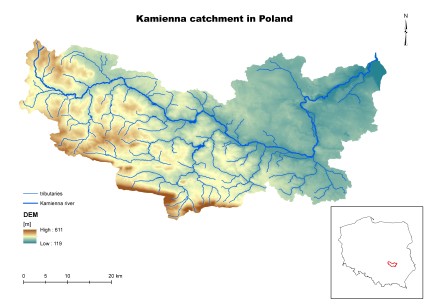Pilot Catchment in Poland
The Kamienna Basin was chosen as a pilot catchment due to the fact that it has a bad ecological status and all of its problems (ie flood, drought, water quality) occur within its area. NWRM can mitigate the problems present in the catchment. These activities are partially already included in the strategic planning documents according to the Polish Water Acts: River Basin Management Plan (EU/PL ; water quality ; 2016), Flood Risk Management Plan (EU/PL ; flood ; 2016), Drougth Impact Mitigation Plan (PL ; drought ; 2017), River Maintenance Plan (PL ; 2016), Water retention plans for forest districts.
| Characteristic | Unit | Value |
| Character of catchment | Lowland/piedmont | |
| Catchment size: | km2 | 2020 |
| Average flow low/avg/high* | m3/s | 2.9/8.3/40 |
| Extreme flow low/high* | m3/s | 0.07/113 |
| Annual precipitation low/avg/high* | mm | 420/640/920 |
| Annual air temperature min/avg/max* | ºC | 3/6/12 |
| Agriculture area | % | 49 |
| Urban area | % | 6.4 |
| Forest area | % | 44.2 |
| Open Water area | % | 0.4 |
| Flooded area (1/100 years) | km2 | 55.6 |
| Artificial drainage area | km2 | 59.2 |
| Ecological status no good/bad | water body | 2/11 |
| Major problems to achieve good ecological status | Phytobenthos, Macrophytes, NH4, PO4, Norganic |
* From multiannual statistic 1951-2013
The catchment area will be a testing ground for the GIS valorization tool for mapping potential locations of N(S)WRM as well as static tools for calculating the static effectiveness of those measures. Data obtained for the catchment will be used for testing dynamic tools (methodology) for calculating the dynamic system effectives of N(S)WRM (SWAT model for catchment analysis and HEC-RAS model for in-stream). Finally a Decision Support System for improving N(S)WRM planning will be prepared on the basis of the lessons learned from the pilot catchment.
The analysis of Kamienna river catchment will result in the improvement of the created tool functionality and design. Valorization maps for various problems (flood, drought, water quality) will be prepared for this catchment. The experience gained during the tool application will be used to prepare guidelines for improving water balance and nutrient mitigation by applying a system of N(S)WRMs and an implementation plan taking into account the relationship between the cost and effect. Stakeholder integration will occur through their engagement in the development of the tool.


